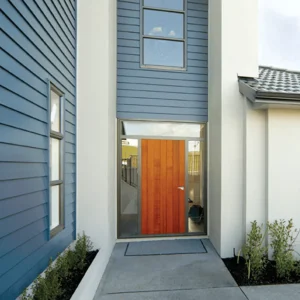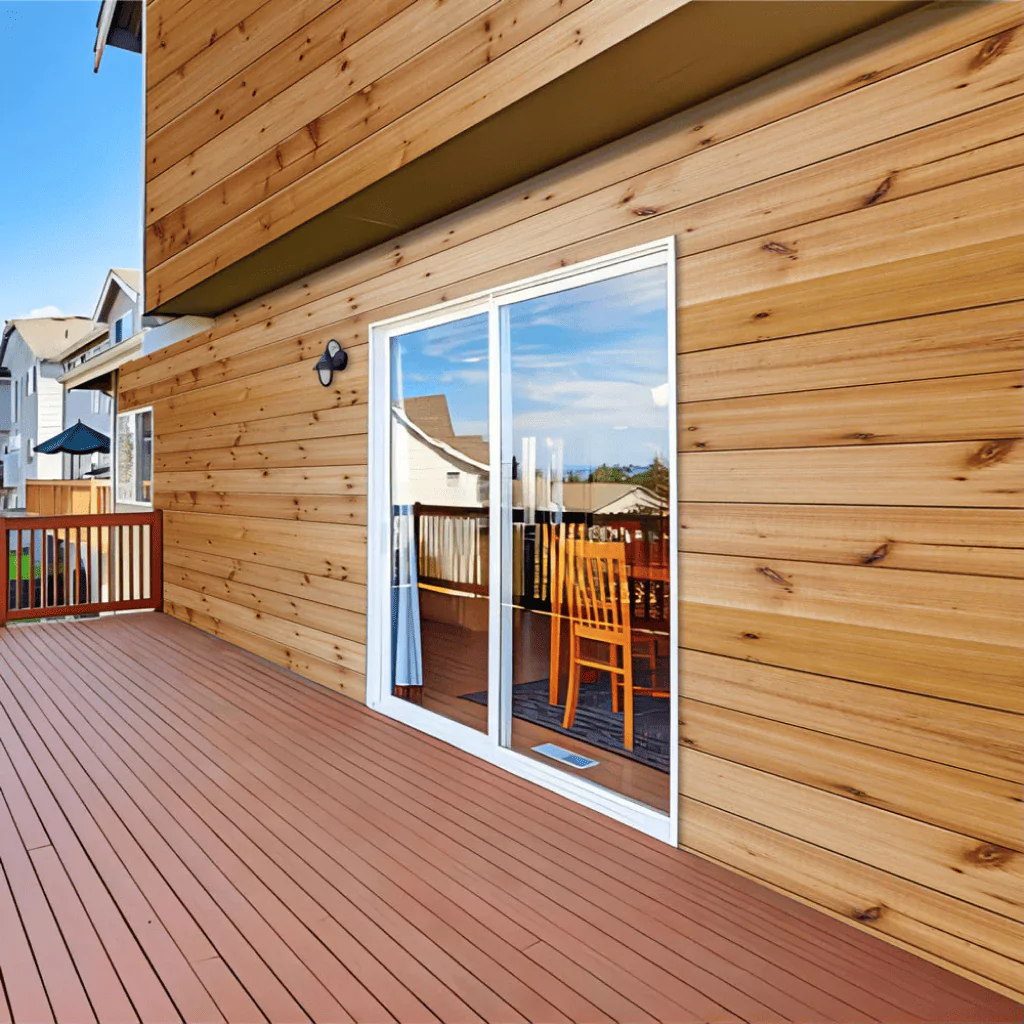

President at Plum ProExteriors
Transform Your Space: A Step-by-Step Guide to Installing Shiplap

Want to give your space a fresh new look? Shiplap is a great choice to make it happen. Shiplap installation really transforms spaces. It’s easy to install and instantly gives off that trendy, rustic vibe everyone loves. Plus, it’s professional-grade stuff. You’ll learn how to nail it like a pro while transforming your house into something that feels straight out of a design magazine. Whether you’re upgrading your facade, backyard side, or side facades, this guide will show you exactly how to get it done.
Now, we’ll get into how to install shiplap on a wall very thoroughly. Point by point, you’ll get a total comprehension of the shiplap wall installation process. Before we turn to the step-by-step explanation of how to install shiplap on drywall, we’ll make it clear which materials and tools you need to be well-equipped. After that, you’ll get a list of maintenance hints required to make your shiplap last.
Ready to learn how do you install shiplap and take your space to the next level? Let’s go!
What you’ll need
To make your dream exterior come true, prepare carefully for the shiplap wall installation.
When you’re learning how to install shiplap on a wall, you should firstly get specific tools and materials to ensure a long-term and pleasurable result.

Here is the must-have list for installing shiplap on wall and how the tools can serve you:
- Hand saw or miter saw (for precise cutting)
- Table saw or coping saw (for cutting difficult angles)
- Cordless drill and drill bits (for creating pilot holes and securing boards)
- Nail gun with finishing nails (for attaching shiplap securely)
- Construction adhesive (PL2000 or equivalent, for extra hold)
- Stud finder (to locate studs behind the wall)
- Laser level or chalk reel kit (to ensure straight alignment)
- Measuring tape (for accurate measurements)
- Utility knife or putty knife (for clean cuts and adjustments)
- Pencil (for marking guidelines)
- Pry bar (for removing obstacles or adjusting boards)
- Hole saw or multitool (for cutting around outlets or fixtures)
- Paintbrush and drop cloth (for finishing touches like painting)
- Drop cloth (to protect floors during installation)
The list can be expanded based on your specific desires and variations of the project. For instance, if you’re looking to change the color of your shiplap, add primer and high-quality paint suited for wood. To maintain the fresh look longer, use sealant or protective varnish to shield them from wear and moisture damage. If you prefer a rustic look, you could use wood stains to enhance the natural grain, followed by a layer of polyurethane to make the finish more durable.
Preparing your space
So, you have all the essential tools and materials to install shiplap wall. How can you organize your space to streamline the shiplap siding installation?
- Clear the area where you’ll be working to ensure you have plenty of space to move around and avoid damaging anything nearby.
- Move furniture, cover floors with drop cloths to protect them from dust, and tape off edges with painter’s tape.
- Ensure your tools and materials are within reach—set up your saw station in a ventilated area to manage dust efficiently.
- Use a chalk reel kit to mark straight, clean lines on the walls, which will act as your guide throughout the process.
- Make sure the area has good ventilation, especially if you’re cutting boards inside. You can set up a dust collector or fan near windows or doorways to keep dust away from your workspace.
This preparation list complements the how to install shiplap paneling guide, being essential to prevent house damage, dust cluster, and confusing mess.
The process of transformation
Installing shiplap on wall seems much less complicated when it’s broken down into clear steps. We created a step-by-step guide on how to install shiplap on wall to facilitate your space enhancement process.
Following these steps, you’ll get a satisfactory result done with ease and precision, ensuring a professional, polished look with every board.
Step 1: Locate and mark wall studs
Before you dive into your shiplap install, it’s important to understand how to attach shiplap to wall securely, especially if you’re working with drywall. Studs are the foundation of your wall and provide the solid structure needed to hold the weight of the shiplap. So, let’s review the basics of operating with studs.
Importance of finding studs
Studs offer the best support for your shiplap. Attaching boards directly to them ensures the panels stay in place and don’t sag over time. Without locating studs first, your shiplap might not be as durable or stable, especially on how to install shiplap over drywall, where studs provide extra strength.
Methods for locating studs
Using a stud finder is the easiest way to locate studs behind your drywall. However, there are a couple of reliable methods to find studs behind your drywall, whether you have a stud finder or need to rely on traditional techniques. Here’s a quick guide to help you locate them.
Using a stud finder
Slowly move the stud finder along the wall. It will beep or light up to mark the location of a stud.
Old-school method (without a stud finder)
Knock gently along the wall. Listen for a solid sound (indicating less hollowness), which likely marks a stud.
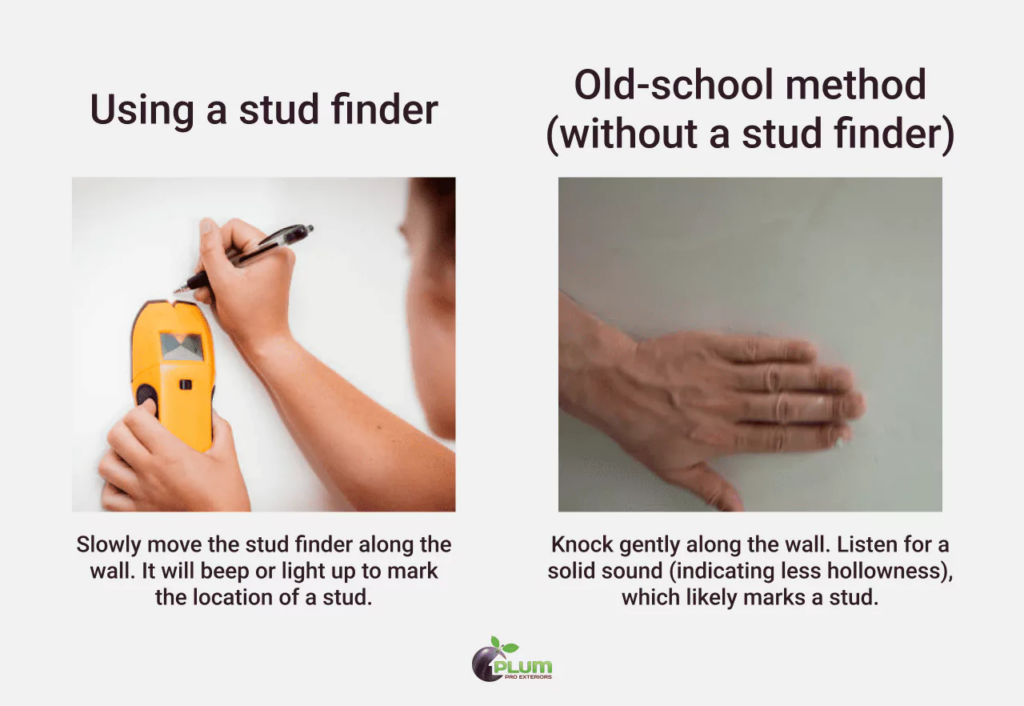
Marking stud locations
Once you find a stud, mark it with a pencil. Be sure to mark all the studs across the entire wall. This will make the rest of your installation process smoother, ensuring each board is attached securely. Additionally, consider measuring and marking the distance between studs (typically 16 or 24 inches apart) to facilitate further installations and ensure accurate placement.
Step 2: Cutting the shiplap boards
After you have found and marked the studs, the next step is to cut your boards for a perfect fit. Whether you’re learning how to install shiplap paneling for the first time or not, you should ensure cutting boards correctly to achieve a clean look.
Measuring and marking boards
Getting your measurements right is super important when you’re putting up shiplap boards. Even a tiny mistake can mess up the whole look, so make sure everything’s spot on.
- Measure the wallFirst, measure the width of your wall and mark where your shiplap boards will go. It’s really important to be accurate because just a little slip can throw everything off. Double-check your measurements before you move on, so you don’t end up with a frustrating mistake later.
- Mark for cutsNext, grab a straight edge to guide your marks—this will help you make clean cuts. Using a straight edge keeps everything looking neat and even. You might also want to use a saw guide or a miter saw for those precise cuts, which will help your installation look high quality and keep those pesky gaps from showing up.
Tips for accurate cuts
Consider these tips when cutting the shiplap boards. With the right techniques, you can make every cut accurate and avoid costly mistakes.
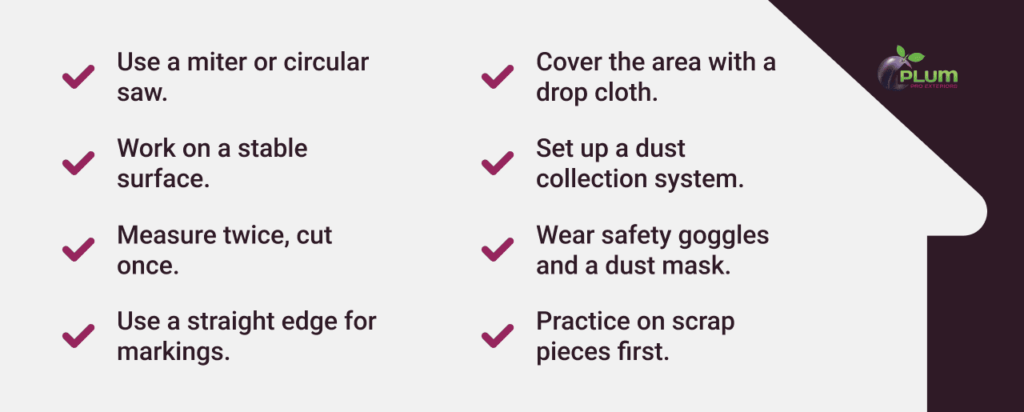
Dealing with outlets and switches
Measure carefully around the openings, and use a jigsaw to make cutouts in your shiplap boards for outlets or switches. Make sure to turn off the power to the outlets before starting your cuts for safety.
Step 3: Installing the first row
The first row of shiplap is critical as it establishes the foundation for the entire installation. Ensuring that this initial row is perfectly level is a must. Any deviation will affect the alignment of subsequent rows.
In particular, when you set the first row, position the board directly at the bottom of the wall. Ensure it is flush against any corners or edges. You can use a level tool to double-check your measurements for accuracy. As you secure it, continuously check for level both horizontally and vertically to confirm it remains straight. Once you are satisfied with the placement, secure the board to the studs using a nail gun or hammer. For additional stability, consider applying construction adhesive to the back of the board.
In the guide on how to attach shiplap to wall, it’s essential to mention the importance of verifying the absence of gaps and strong anchorage after each step of installation. When the board is attached, step back and visually inspect the alignment to look for the gaps at the edges and that it sits evenly against the wall. Finally, confirm that the board is securely fastened to the studs and holds firm before moving on to the next row.
Step 4: Continuing the installation
The 4th step implies installing shiplap on walls one row at a time.
Using spacers for consistent gaps
To get that perfect, even gap between each board, use spacers. With the tool, you ensure uniformity and give your shiplap a classic look. Place spacers between the boards as you install each row. As you secure the next board, the spacers (wood pieces, plastic spacers, or even coins, depending on the gap size you need) will keep the distance consistent.
So, you can purchase them, or, if you want to learn how to put up shiplap with more hand work, you can use nickels or small wood scraps for DIY spacers.
Staggering seams for a natural look
When considering how to attach shiplap to wall for the best visual result, staggering your seams helps break up the pattern and makes the wall feel more natural and less repetitive.
To do this, start one row with a full-length board and the next with a shorter one to shift the seams. Alternate the starting points on each row to keep things looking balanced. Staggering your seams doesn’t just improve the appearance, but it also strengthens the overall installation by spreading out the joints.
Tips for corners and edges
Getting corners and edges right is essential for a great shiplap look. Check out these essential tips to help you make clean cuts and secure everything for a polished finish.

Step 5: Working around obstacles
When you look for how to attach shiplap to drywall, you’ll discover that it has specific obstacles as well as any other house installation work. It’s important to acknowledge them on the shore to be able to cope with them and not lose the quality and efficiency of the process.

The most common obstacles that get in the way of someone who wants to advance their space with a shiplap are outlets on a summer veranda and windows. Let’s figure out how to cope with them.
Cutting boards for outlets and switches
The boards for switches and outlets are not as scary as it may seem, though they interrupt the smooth flow of your shiplap boards. However, a clear instruction is a cure again:
- Turn off the power for safety.
- Mark the exact location of the outlets or switches on your shiplap board.
- Measure carefully, making sure the cutout is just the right size—not too big or small.
- Use a jigsaw or coping saw to cut around the markings, and go slow to keep the cuts clean.
- Before attaching the board, test-fit it to ensure the opening is snug around the outlet or switch. If needed, sand the edges of your cuts for a smoother fit.
- Once you’re satisfied, secure the board to the wall.
Dealing with windows and doors
In case you have an intrusive window preventing you from a seamless shiplap installation, follow this specific steps:
- Measure the height and width of the spaces carefully, and mark your boards accordingly.
- Cut slowly with a miter or circular saw, ensuring your cuts are straight and match the frame edges.
- After attaching the boards, check for any gaps. If there are small imperfections, use trim pieces to cover them up.
- For a finished look, apply caulk around the edges where the shiplap meets the window or door frame.
Overall, you can overcome easily the possible barriers such as outlets, switches, or windows.
Step 6: Installing the final row
Congratulations! You’re at the finish line of mastering how to install shiplap siding. Be careful, the last row is where you really should focus on detail.

Measuring and cutting the top row
The top row often requires narrower boards since the remaining space between the second-to-last board and the ceiling or molding may not be wide enough for a full board. Because walls aren’t always perfectly straight, you should take measurements at multiple points across the top. Thus, you can account for any slight variations in the width of the gap. Start by measuring the height of the remaining gap along the entire length of the wall.
Techniques for a tight fit
The tight fit is a synonym of longevity in how to nail shiplap to wall. To handle the responsible task, put some construction adhesive on the back of the board before you install it to keep it stuck firmly to the wall and stop it from shifting later. Then, position the board carefully, making sure it’s lined up perfectly with the ceiling or trim.
When the board is settled, use a nail gun to secure it to the studs. You can add extra nails along the edges for more support, especially if the top row isn’t as visible. If space is tight, use finished nails and a hammer instead. After it’s nailed in, check for gaps. If needed, caulk between the board and the ceiling or molding for a clean, seamless look.
Step 7: Finishing touches
All you have to do now is sand the remaining parts, and that’s how to attach shiplap to drywall successfully. Some of them are optional, but they definitely can enhance your space further. Let’s review the necessary and optional finishing touches.
Filling nail holes
This process is a must for a smooth, professional finish. After you’ve nailed the boards into place, use wood filler or spackle to cover each nail hole. Let it dry, then lightly sand the spots to ensure the surface is even. Thus, you can achieve a flawless look. This step is essential before any painting or staining.
Caulking gaps (if desired)
Caulking gaps is optional but can make a big difference in how polished your project looks. If there are visible gaps between the boards or along the edges, especially near corners or the roof, applying caulk gives the whole wall a seamless appearance. This is particularly useful if your walls aren’t perfectly even or if the boards don’t line up perfectly. It’s not necessary, but it definitely helps if you’re aiming for a flawless look.
Painting or staining (if needed)
Painting or staining is another optional step, depending on the look you’re going for. If your boards are unfinished or you want a specific color, you can paint or stain them to match your style. Make sure to fill and sand the nail holes first for the best result. Whether you go with paint for a clean, modern finish or stain for a more rustic feel, this step adds the final touch to your shiplap installation.
Maintenance and care
How to install shiplap wall is half of the affair, while how to shiplap a wall so it last at least 20 is a real challenge. Not only the installation process but the right care and maintenance are crucial.
Consider the hints below to keep the shiplap fresh and good-looking for as long as possible.
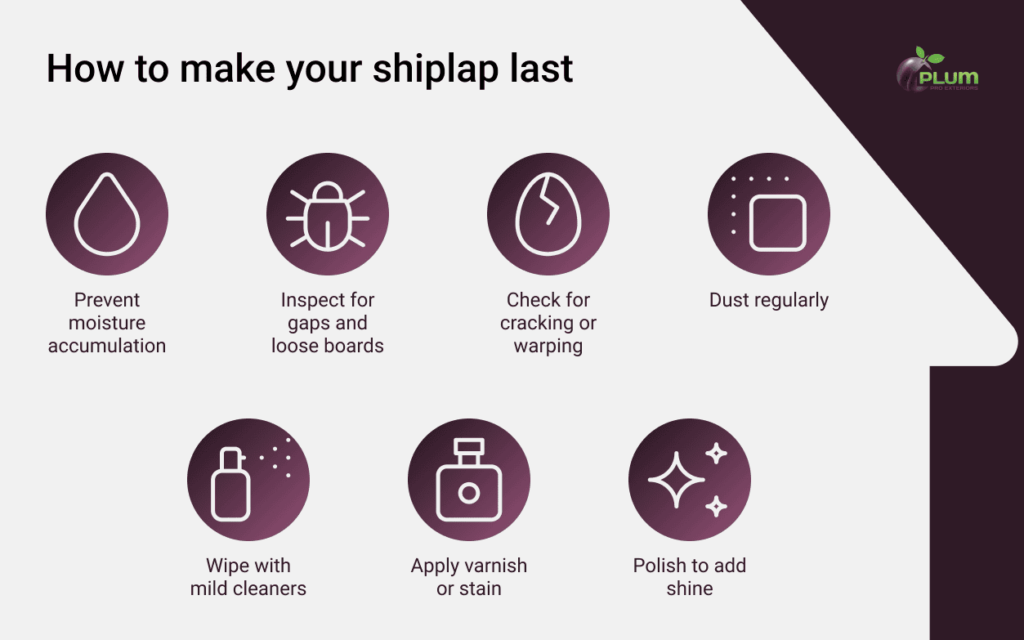
- Prevent moisture accumulation: Moisture can spoil and weaken your shiplap, especially in bathrooms or kitchens. Make sure the room is well-ventilated to prevent moisture from damaging the boards. Use dehumidifiers or exhaust fans where needed to control humidity.
- Inspect for gaps and loose boards: As walls settle, boards may shift slightly. If you notice gaps, apply a little caulk to fill them in. If a board becomes loose, use finishing nails to secure it back in place.
- Check for cracking or warping: Temperature and humidity changes can cause shiplap boards to crack or warp. Watch for signs of the wood expanding or shrinking. If you see cracks, fill them with wood filler and sand them smooth. For warping, try securing the board back in place or replace it if needed.
- Dust regularly: Use a microfiber cloth or a soft brush to clean the grooves between the boards. This helps prevent dust buildup, which can dull the look of your shiplap over time.
- Wipe with mild cleaners: For tougher dirt or grime, wipe using a mild soap and water solution. Avoid harsh chemicals that could damage the paint or stain. Gently scrub any stubborn spots with a soft sponge, then dry with a clean cloth.
- Apply varnish or stain: Shiplap may show signs of wear, especially if it’s in a high-traffic area. Keep a small amount of the original paint or stain on hand for touch-ups. Thus, your shiplap stays looking fresh without having to repaint or refinish the entire wall.
- Polish to add shine: To make it look exceptional for long, apply a wood-safe polish to enhance its shine and keep it looking fresh. Be sure to use a product designed for the finish on your boards—whether it’s a matte, satin, or glossy finish.
Conclusion
To install shiplap is a relatively easy but effective way to give your space a fresh look. How to install shiplap on drywall ceases to seem complicated when divided into clear steps. When learning how to put shiplap on a wall on your exterior, following the steps from this guide will provide you with a professional, lasting finish.
You can always turn to Plum ProExteriors for an expert and seamless shiplap installation. Contact us and let us handle the work and give your home that stunning, polished look from your dreams!


